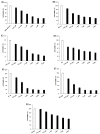Functional Characterization and Anti-Tumor Effect of a Novel Group II Secreted Phospholipase A2 from Snake Venom of Saudi Cerastes cerates gasperetti
- PMID: 37764293
- PMCID: PMC10536776
- DOI: 10.3390/molecules28186517
Functional Characterization and Anti-Tumor Effect of a Novel Group II Secreted Phospholipase A2 from Snake Venom of Saudi Cerastes cerates gasperetti
Abstract
Secreted phospholipases A2 are snake-venom proteins with many biological activities, notably anti-tumor activity. Phospholipases from the same snake type but different geographical locations have shown similar biochemical and biological activities with minor differences in protein sequences. Thus, the discovery of a new phospholipase A2 with unique characteristics identified in a previously studied venom could suggest the origins of these differences. Here, a new Group II secreted phospholipase A2 (Cc-PLA2-II) from the snake venom of Saudi Cerastes cerastes gasperetti was isolated and characterized. The purified enzyme had a molecular weight of 13.945 kDa and showed high specific activity on emulsified phosphatidylcholine of 1560 U/mg at pH 9.5 and 50 °C with strict calcium dependence. Interestingly, stability in extreme pH and high temperatures was observed after enzyme incubation at several pH levels and temperatures. Moreover, a significant dose-dependent cytotoxic anti-tumor effect against six human cancer cell lines was observed with concentrations of Cc-PLA2 ranging from 2.5 to 8 µM. No cytotoxic effect on normal human umbilical-vein endothelial cells was noted. These results suggest that Cc-PLA2-II potentially has angiogenic activity of besides cytotoxicity as part of its anti-tumor mechanism. This study justifies the inclusion of this enzyme in many applications for anticancer drug development.
Keywords: anti-tumor effect; cytotoxicity; human cancer cell lines; secreted phospholipase A2; snake venom; stability.
Conflict of interest statement
The authors declare no conflict of interest.
Figures





Similar articles
-
Two purified and characterized phospholipases A2 from Cerastes cerastes venom, that inhibit cancerous cell adhesion and migration.Toxicon. 2009 Mar 15;53(4):444-53. doi: 10.1016/j.toxicon.2009.01.003. Toxicon. 2009. PMID: 19708222
-
MVL-PLA2, a phospholipase A2 from Macrovipera lebetina transmediterranea venom, inhibits tumor cells adhesion and migration.Matrix Biol. 2009 May;28(4):188-93. doi: 10.1016/j.matbio.2009.03.007. Epub 2009 Apr 5. Matrix Biol. 2009. PMID: 19351557
-
CC-PLA2-1 and CC-PLA2-2, two Cerastes cerastes venom-derived phospholipases A2, inhibit angiogenesis both in vitro and in vivo.Lab Invest. 2010 Apr;90(4):510-9. doi: 10.1038/labinvest.2009.137. Epub 2010 Feb 8. Lab Invest. 2010. PMID: 20142800
-
Antitumoral potential of Tunisian snake venoms secreted phospholipases A2.Biomed Res Int. 2013;2013:391389. doi: 10.1155/2013/391389. Epub 2013 Jan 31. Biomed Res Int. 2013. PMID: 23509718 Free PMC article. Review.
-
The Contribution of Phospholipase A2 and Metalloproteinases to the Synergistic Action of Viper Venom on the Bioenergetic Profile of Vero Cells.Toxins (Basel). 2022 Oct 23;14(11):724. doi: 10.3390/toxins14110724. Toxins (Basel). 2022. PMID: 36355974 Free PMC article. Review.
Cited by
-
Effective Soybean Oil Degumming by Immobilized Phospholipases A2 from Walterinnesia aegyptia Venom.ACS Omega. 2024 May 1;9(19):21322-21332. doi: 10.1021/acsomega.4c01558. eCollection 2024 May 14. ACS Omega. 2024. PMID: 38764629 Free PMC article.
References
MeSH terms
Substances
LinkOut - more resources
Full Text Sources

